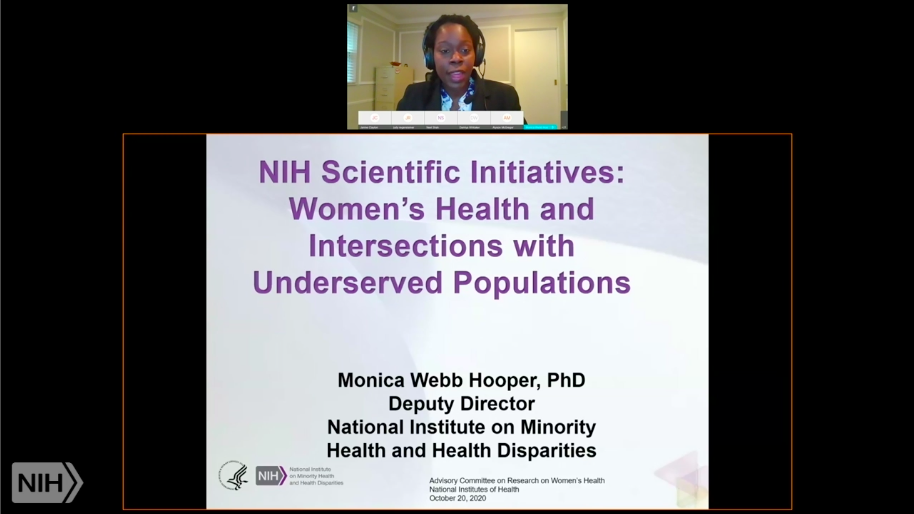Addressing Impact of COVID-19 on Women from Underserved Communities

This is the third in a series of blog posts exploring COVID-19 from a women’s health perspective.
On October 20, 2020, the Office for Women’s Health Research (ORWH) at the National Institute of Health (NIH) held its 51st Meeting of the NIH Advisory Committee on Research on Women’s Health. The panel titled “COVID-19 and the Health of Women” featured insightful presentations on the pandemic’s distinctive impact on women’s health. This blog series will explore each of the three sessions.
In the final presentation of the panel on COVID-19 and the health of women, Dr. Monica Webb Hooper stressed that to achieve health equity, it is important to understand the health of underserved women. This understanding will lead to well-defined social determinants of health to aid in the development of interventions and increase equal access to innovations that improve health.
Dr. Webb Hooper noted that “the biomedical literature has treated women as a monolithic group”. This approach presumes that the factors that affect health are applicable to all women and may mask the unique experiences of various women based on social categories.
African-American women are particularly affected, having decreased life expectancy and poorer health when compared to white women. African-American women also have lower mean income when compared to white women. Household income is directly related to all-cause mortality — the risk of death of any cause is greater for households with low incomes. Latino women had the lowest mean income, yet despite their socioeconomic disadvantage and a higher burden of disease, this group had decreased all-cause mortality. This phenomenon is likely attributed to the “healthy migrant effect” as described by the Hispanic mortality paradox.
“Racial/ethnic differences in COVID-19 are driven by differences in exposure,” said Dr. Webb Hooper. Minority women comprise a large portion of essential workers, increasing their chances of being infected. COVID-19 has unfolded a series of emerging issues that could increase disparities among women: the effect the pandemic will have on mental health, adverse impact on careers and employment, increased responsibility of women to be primary caregivers, and biological factors such as obesity.
The decline in willingness to receive a COVID-19 vaccine among women and racial minorities is a battle that will require a critical, strategic response from science. The NIH has developed research initiatives to address COVID-19 related health disparities and to increase trust in science. The Rapid Acceleration of Diagnostics-Underserved Populations (RADx-UP) is a $500 million dollar initiative to study COVID-19 testing among underserved and vulnerable populations. The goal of this consortium of community-engaged research projects is to reduce COVID-19 associated morbidity and mortality disparities. The Community Engagement Alliance (CEAL) Against COVID-19 Disparities is an NIH-wide initiative that will lead to urgent community engagement and outreach efforts to address misinformation and mistrust in underserved communities. CEAL teams will establish communication networks across multiple channels and will also promote participation in clinical trials. Dr. Webb Hooper is hopeful that the aforementioned initiatives combined with the ongoing projects at NIH “will contribute to the diversity in research and significant reductions in COVID-19 health disparities”.
You can watch the full ORWH event here.
This blog post was written by Keila Miles, PhD, a science policy fellow at Research!America. The Science Policy Fellowship is sponsored by the Howard Hughes Medical Institute.




